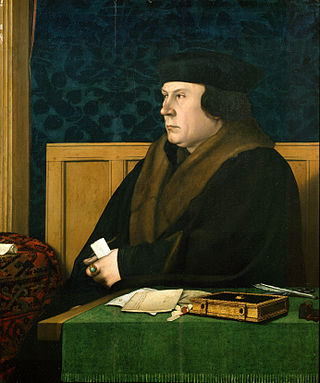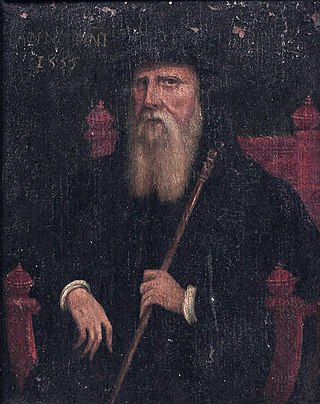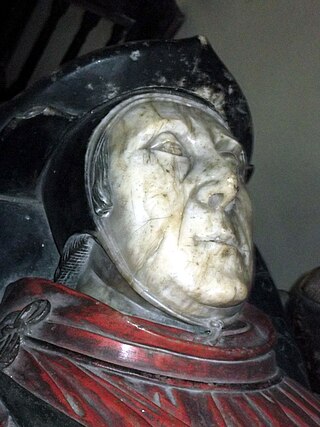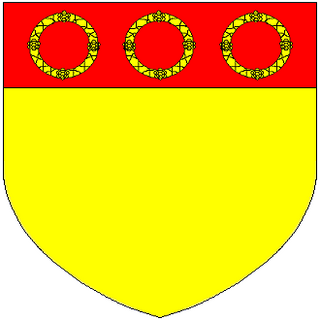
Oliver Cromwell was an English statesman, politician, and soldier, widely regarded as one of the most important figures in British history. He came to prominence during the Wars of the Three Kingdoms, initially as a senior commander in the Parliamentarian army and latterly as a politician. A leading advocate of the execution of Charles I in January 1649, which led to the establishment of the Commonwealth of England, he ruled as Lord Protector from December 1653 until his death in September 1658.

Thomas Cromwell, briefly Earl of Essex, was an English statesman and lawyer who served as chief minister to King Henry VIII from 1534 to 1540, when he was beheaded on orders of the king, who later blamed false charges for the execution.

The Protectorate, officially the Commonwealth of England, Scotland and Ireland, was the English form of government lasting from 16 December 1653 to 25 May 1659, under which the kingdoms of England, Scotland, and Ireland, with their associated territories were joined together in the Commonwealth of England, governed by a Lord Protector. It began when Barebone's Parliament was dissolved, and the Instrument of Government appointed Oliver Cromwell as Lord Protector of the Commonwealth. Cromwell died in September 1658 and was succeeded by his son Richard Cromwell.

John Russell, 1st Earl of Bedford was an English royal minister in the Tudor era. He served variously as Lord High Admiral and Lord Privy Seal. Among the lands and property he was given by Henry VIII after the Dissolution of the Monasteries, were the Abbey and town of Tavistock, and the area that is now Covent Garden. Russell is the ancestor of all subsequent Earls and Dukes of Bedford and Earls Russell, including John Russell, Prime Minister of the United Kingdom, and philosopher Bertrand Russell.

Thomas Wriothesley, 1st Earl of Southampton, KG was an English peer, secretary of state, Lord Chancellor and Lord High Admiral. A naturally skilled but unscrupulous and devious politician who changed with the times, Wriothesley served as a loyal instrument of King Henry VIII in the latter's break with the Catholic church. Richly rewarded with royal gains from the Dissolution of the Monasteries, he nevertheless prosecuted Calvinists and other Protestants when political winds changed.

Elizabeth Seymour was a younger daughter of Sir John Seymour of Wulfhall, Wiltshire and Margery Wentworth. Elizabeth and her sister Jane served in the household of Anne Boleyn, the second wife of Henry VIII. The Seymours rose to prominence after the king's attention turned to Jane. In May 1536, Anne Boleyn was accused of treason and adultery, and subsequently executed. On 30 May 1536, eleven days after Anne's execution, Henry VIII and Jane were married. Elizabeth was not included in her sister's household during her brief reign, although she would serve two of Henry VIII's later wives, Anne of Cleves and Catherine Howard. Jane died 24 October 1537, twelve days after giving birth to a healthy son, Edward VI.

Sir Ralph Sadler or Sadleir PC, Knight banneret was an English statesman, who served Henry VIII as Privy Councillor, Secretary of State and ambassador to Scotland. Sadler went on to serve Edward VI. Having signed the device settling the crown on Jane Grey in 1553, he was obliged to retire to his estates during the reign of Mary I. Sadler was restored to royal favour during the reign of Elizabeth I, serving as a Privy Councillor and once again participating in Anglo-Scottish diplomacy. He was appointed Chancellor of the Duchy of Lancaster in May 1568.

Gregory Cromwell, 1st Baron Cromwell, KB was an English nobleman. He was the only son of the Tudor statesman Thomas Cromwell, 1st Earl of Essex and Elizabeth Wyckes.

Sir Thomas Bromley was an English judge of Shropshire landed gentry origins who came to prominence during the Mid-Tudor period. After occupying important judicial posts in the Welsh Marches, he won the favour of Henry VIII and was a member of Edward VI's regency council. He was appointed Chief Justice of the King's Bench by Mary I.

Sir Richard Morrison was an English humanist scholar and diplomat. He was a protégé of Thomas Cromwell, propagandist for Henry VIII, and then ambassador to the German court of Charles V for Edward VI.
Sir Gerald Aylmer was an Irish judge in the time of Henry VIII, who played a key part in enforcing the Dissolution of the Monasteries. His numerous descendants included the Barons Aylmer.

Catherine Howard was Queen of England from July 1540 until November 1541 as the fifth wife of King Henry VIII. She was the daughter of Lord Edmund Howard and Joyce Culpeper, a cousin to Anne Boleyn, and the niece of Thomas Howard, 3rd Duke of Norfolk. Thomas Howard was a prominent politician at Henry's court. He secured her a place in the household of Henry's fourth wife, Anne of Cleves, where Howard caught the King's interest. She married him on 28 July 1540 at Oatlands Palace in Surrey, just 19 days after the annulment of his marriage to Anne. He was 49, and it is widely accepted that she was about 17 at the time of her marriage to Henry VIII.

Sir Richard Williams, also known as Sir Richard Cromwell, was a Welsh soldier and courtier in the reign of Henry VIII who knighted him on 2 May 1540. He was a maternal nephew of Thomas Cromwell, profiting from the Dissolution of the Monasteries in which he took an active part. He was the patrilineal great-grandfather of Oliver Cromwell.
Sir Humphrey Wingfield was an English lawyer and Speaker of the House of Commons of England between 1533 and 1536.
Sir Thomas LeighorLegh (?1511–1545) was an English jurist and diplomat, who played a key role as agent of Henry VIII and Thomas Cromwell in the Dissolution of the Monasteries.
Sir Anthony Lee was an English courtier and Member of Parliament, and the father of Elizabeth I's champion, Sir Henry Lee. He was at the court of Henry VIII in his youth, and served as a Justice of the Peace and Knight of the Shire for Buckinghamshire. He was a close friend of his brother-in-law, the poet Sir Thomas Wyatt.
Patrick Barnewall was a leading figure in the Irish Government of the 1530s and 1540s. He owed his position largely to his close links with Thomas Cromwell. He sat in the Irish House of Commons as MP for County Dublin, and held the offices of Solicitor General for Ireland and Master of the Rolls in Ireland. Today he is mainly remembered for his role in founding the King's Inns. He belonged to a junior branch of the family of Lord Trimlestown: his own descendants held the title Viscount Barnewall of Kingsland.

James fitz John FitzGerald, 13th Earl of Desmond, also counted as the 14th, ruled 22 years, the first 4 years as de facto earl until the death of James FitzGerald, de jure 12th Earl of Desmond, called Court Page, who was murdered by James fitz John's brother Maurice fitz John FitzGerald, called Totane. James fitz John FitzGerald maintained himself in power by skilful diplomacy, avoiding armed conflict and destruction. He was appointed Lord Treasurer of Ireland in 1547.

Sir Maurice Berkeley of Bruton in Somerset and of Berkeley House, Clerkenwell, Middlesex, served as Chief Banner Bearer of England to Kings Henry VIII and Edward VI and to Queen Elizabeth I, and rose rapidly in the Tudor court. He came from a cadet branch of the great Berkeley family of Berkeley Castle in Gloucestershire, but in his career, his initial advantage was due to his mother's second marriage to Sir John FitzJames, Lord Chief Justice of the King's Bench 1526–1539, which by 1538 had brought him into the household of Thomas Cromwell, from which he passed into the royal household by 1539.

The Cromwell family is an English aristocratic family descended from Hugh de Cromwell who came to England with William the Conqueror. Its most famous members are: Thomas Cromwell, 1st Earl of Essex; and, Oliver Cromwell, the Lord Protector. The line of Oliver Cromwell descends from Richard Williams, son of Thomas Cromwell's sister Katherine and her husband Morgan Williams.















